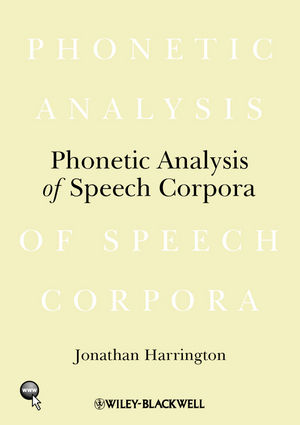Phonetic Analysis of Speech CorporaISBN: 978-1-4051-4169-7
Hardcover
424 pages
April 2010, Wiley-Blackwell
 This is a Print-on-Demand title. It will be printed specifically to fill your order. Please allow an additional 15-20 days delivery time. The book is not returnable.
Other Available Formats: Paperback
|
||||||
Relationship between Machine Readable (MRPA) and International Phonetic Alphabet (IPA) for Australian English.
Relationship between Machine Readable (MRPA) and International Phonetic Alphabet (IPA) for German.
Downloadable Speech Databases Used in this Book.
Preface.
Notes on Downloading Software.
1. Using Speech Corpora in Phonetics Research.
1.1 The Place of Corpora in the Phonetic Analysis of Speech.
1.2 Existing Speech Corpora for Phonetic Analysis.
1.3 Designing Your Own Corpus.
1.4 Summary and Structure of the Book.
2. Some Tools for Building and Querying Annotated Speech Databases.
2.1 Overview.
2.2 Getting Started with Existing Speech Databases.
2.3 Interface between Praat and Emu.
2.4 Interface to R.
2.5 Creating a New Speech Database: From Praat to Emu to R.
2.6 A First Look at the Template File.
2.7 Summary.
2.8 Questions.
3. Applying Routines for Speech Signal Processing.
3.1 Introduction.
3.2 Calculating, Displaying, and Correcting Formants.
3.3 Reading the Formants into R.
3.4 Summary.
3.5 Questions.
3.6 Answers.
4. Querying Annotation Structures.
4.1 The Emu Query Tool, Segment Tiers, and Event Tiers.
4.2 Extending the Range of Queries: Annotations from the Same Tier.
4.3 Inter-tier Links and Queries.
4.4 Entering Structured Annotations with Emu.
4.5 Conversion of a Structured Annotation to a Praat TextGrid.
4.6 Graphical User Interface to the Emu Query Language.
4.7 Re-querying Segment Lists.
4.8 Building Annotation Structures Semi-automatically with Emu-Tcl.
4.9 Branching Paths.
4.10 Summary.
4.11 Questions.
4.12 Answers.
5. An Introduction to Speech Data Analysis in R: A Study of an EMA Database.
5.1 EMA Recordings and the ema5 Database.
5.2 Handling Segment Lists and Vectors in Emu-R.
5.3 An Analysis of Voice-Onset Time.
5.4 Intergestural Coordination and Ensemble Plots.
5.5 Intragestural Analysis.
5.6 Summary.
5.7 Questions.
5.8 Answers.
6. Analysis of Formants and Formant Transitions.
6.1 Vowel Ellipses in the F2ÍF1 Plane.
6.2 Outliers.
6.3 Vowel Targets.
6.4 Vowel Normalization.
6.5 Euclidean Distances.
6.6 Vowel Undershoot and Formant Smoothing.
6.7 F2 Locus, Place of Articulation, and Variability.
6.8 Questions.
6.9 Answers.
7. Electropalatography.
7.1 Palatography and Electropalatography.
7.2 An Overview of Electropalatography in Emu-R.
7.3 EPG Data-Reduced Objects.
7.4 Analysis of EPG Data.
7.5 Summary.
7.6 Questions.
7.7 Answers.
8. Spectral Analysis.
8.1 Background to Spectral Analysis.
8.2 Spectral Average, Sum, Ratio, Difference, Slope.
8.3 Spectral Moments.
8.4 The Discrete Cosine Transformation.
8.5 Questions.
8.6 Answers.
9. Classification.
9.1 Probability and Bayes’ Theorem.
9.2 Classification: Continuous Data.
9.3 Calculating Conditional Probabilities.
9.4 Calculating Posterior Probabilities.
9.5 Two Parameters: The Bivariate Normal Distribution and Ellipses.
9.6 Classification in Two Dimensions.
9.7 Classifications in Higher Dimensional Spaces.
9.8 Classifications in Time.
9.9 Support Vector Machines.
9.10 Summary.
9.11 Questions.
9.12 Answers.
References.
Index.



